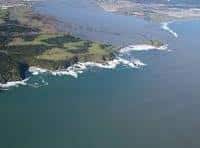Before entering fully into the meaning of the term mouth, let's know its etymological origin. In this case we can establish that it derives from Latin, since it is the result of the sum of several components of said language:
-The prefix “des-”, which is used to indicate the investment of an action.
-The “en-” component, which means “inwards”.
-The noun “bucca”, which can be translated as “mouth”.
-The suffix “-adura”, which is used to indicate “result”.
The place where a river empties or enters another, a lake or the sea is called the mouth . The mouth can take different shapes depending on the characteristics of the terrain.
 In this part of the course , the flow of water reaches the place where it empties. The mouth may even have an underwater extension through a canyon or a sedimentation site.
In this part of the course , the flow of water reaches the place where it empties. The mouth may even have an underwater extension through a canyon or a sedimentation site.
The mouth, by carrying river sediments, can form a delta . In these cases the river divides into a large number of arms, forming channels and islands. The Orinoco delta , for example, is the mouth of this river that originates and ends in Venezuelan territory but also crosses regions of Colombia .
The Danube River, which is one of the most important on the entire European continent, flows into the Black Sea through what is known as the Danube Delta, which is located between the Romanian lands of Dobrogea and the Ukrainian lands of Odessa. This delta has just over 3,400 square kilometers and is considered the largest and best preserved of the rivers that exist in Europe.
When the mouth of a river takes place in the sea, an estuary can develop. In this type of mouth there is an exchange between the fresh water of the river and the salt water of the sea. The Thames estuary , to cite one case, occurs in the area where this river empties into the North Sea .
Another geographical feature that a mouth can cause is the estuary . In this case, the river basin has steep slopes and the sea ends up entering the coast due to the movement of the tides, causing the river valley to become submerged. A well-known estuary is that of Bilbao , at the mouth of the Ibaizábal and Nervión rivers and their tributaries into the Cantabrian Sea .
In Spain, without a doubt, there is a lot of talk about the mouth of the Guadalquivir River, since it is in an area of great beauty and natural value. Specifically, it flows into the Atlantic Ocean through an estuary that is located between the Cadiz town of Sanlúcar de Barrameda and the Huelva municipality of Almonte.
Likewise, it should be noted that between that estuary and Seville are the famous Guadalquivir marshes, which have an area of about 2,000 square kilometers and a part of which is part of the relevant Doñana National Park, which is declared UNESCO World Heritage Site.
Finally, it should be noted that the idea of mouth can refer to the opening of a road : “At the mouth of this street there is a beautiful square,” “The mouth of the tunnel was blocked by snow.”
